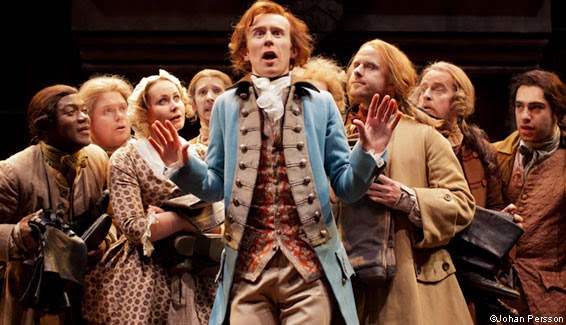Sturm
und Drang - Goethe, German Theatre in the 18th Century and a New Theatre Aesthetic
Goethe was born at Frankfort-on-Main in 1749. His early education was received at home, first under his father, and then with tutors, though the influence of his mother was strongly marked. In his Dichtung und Wahrheit Goethe tells of his early interest in puppet-plays and theaters, and in the French company of actors which remained in his native city after the Seven Years' War. These early years were devoted to literary effort, though the youth found time for at least one love-affair before reaching the age of sixteen.
In 1765 he
went to Leipzig and entered the University. There a second love-affair inspired
a number of juvenile lyrics. Two minor plays also belong to this period. As a
result of illness he was sent home, and during his convalescence he read and
studied. When, in 1770, after his recovery, he went to Strassburg to study law,
he was completely changed. He took up in earnest his work of criticizing French
art and standing for a truly German art. He was greatly influenced by Herder,
who showed him the beauty of Shakespeare. Another love-affair went far to
inspire him in his first important lyrics, which were to mark a new epoch in
German poetry. Götz von Berlichingen was written at Strassburg (though not
published until 1773); with this play Shakespeare's art first triumphed on the
German stage, and the literary movement known as Sturm und Drang was
inaugurated. Goethe received his degree in 1771 and returned to Frankfurt,
where he began to practice his profession. Friendships, further love-affairs,
and writing, occupied the years previous to his Weimar residence.
Die
Leiden des jungen Werthers (1774) brought Goethe widespread fame. The first studies for Faust also
date from this time, and a number of complete plays. His trip to Weimar was
made after repeated invitations by the "hereditary prince," Karl
August. At Weimar Goethe was entrusted with state affairs. The years between
his arrival there and his famous Italian trip are chiefly memorable for some of
the poet's best lyrics, a large part of Wilhelm Meisters theatralische Sendung,
and Iphigenie auf Tauris. In 1786 he went to Italy. The final version of
Iphigenie (1787), Torquato Tasso (1790), Egmont (1788), and the Fragment of
Faust (1790), were all influenced by this journey. He returned to Weimar in
1788. There he lived with Christiane Vulpius for many years, finally marrying
her in 1806. During the stormy years of the French Revolution Goethe took part
in the French Campaign in 1792 and the Siege of Mainz in 1793.
The
Revolution meant little to him but the unsettling of the government and order.
A few very uneven plays of his bear witness to his dissatisfaction. In 1791 he
was appointed director of the Ducal theater. At the same time he was occupied
with biological, physical, botanical, and chemical research, and many works
appeared with the results of his inquiries. The revised and extended version of
Wilhelm Meister was included in his Neue Schriften (1792-1800), and exerted
great influence.
In 1794 he
and Schiller became friends, and Goethe collaborated with the latter in his
Horen. Schiller stimulated Goethe and encouraged him to further literary
efforts. In 1798 Goethe published his epic Hermann und Dorothea and many
ballads. Ten years later appeared the first part of Faust, and the next year
the novel Die Wahlverwandtschaften, which was very popular. Aus meinem Leben,
Dichtung und Wahrheit, part I, was published in 1811. Additional parts appeared
in 1812, 1814, and the last, after his death. His wife died in 1816. The next year
he retired from his position as theater director. The second part of Faust
appeared in 1833. He died at Weimar in 1832.
Throughout
a great part of Goethe's work there is a stream of criticism which renders it
difficult to re-construct a complete critical theory. The various versions of
the Wilhelm Meister novel, even Faust itself, are critical in spirit. But it is
in the miscellaneous prefaces, articles, letters, and the Eckermann Gespräche--Conversations--that
his critical powers are best seen. Goethe's broad outlook, his sympathy with
and his deep knowledge of man and art, gave him a most catholic view, and
possibly the best statement of his creed is found in Calvin Thomas' Goethe:
“… the
simple creed that informs Goethe, and gives him his criteria for judging the
work of others. It is that the artist as such must have no creed; that is no
creed derivable from the intellect or accountable to it. Rules, conventions,
theories, principles, inhibitions of any sort not born of his own immediate
feeling, are no concern of his. They proceed from an inferior part of human
nature, being the work of gapers and babblers."
Exercises
Goethe believed that we are not separate from the objects around us and the aesthetics of our surroundings. Look at a painting or a sketch of a person or character which shows them in a space surrounded by objects or nature. Now start to create that character not from their own internal world but by making the external world and the objects and surroundings create the internal world of the character you portray. Let external aesthetics create the personality and inner world of the character you create.
Exercises
Goethe believed that we are not separate from the objects around us and the aesthetics of our surroundings. Look at a painting or a sketch of a person or character which shows them in a space surrounded by objects or nature. Now start to create that character not from their own internal world but by making the external world and the objects and surroundings create the internal world of the character you portray. Let external aesthetics create the personality and inner world of the character you create.


